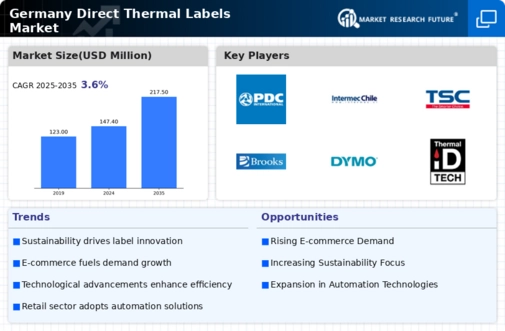Rising E-commerce Demand
The surge in e-commerce activities in Germany is a pivotal driver for the direct thermal-labels market. As online shopping continues to gain traction, businesses require efficient labeling solutions for shipping and inventory management. In 2025, e-commerce sales in Germany are projected to reach approximately €100 billion, indicating a robust growth trajectory. This increase necessitates the adoption of direct thermal-labels, which offer quick printing capabilities and cost-effectiveness. Retailers and logistics companies are increasingly relying on these labels to streamline their operations, enhance customer satisfaction, and reduce operational costs. The direct thermal-labels market is thus positioned to benefit significantly from this trend, as companies seek reliable labeling solutions to meet the demands of a rapidly evolving retail landscape.
Consumer Preference for Customization
Consumer preferences in Germany are shifting towards personalized products, which is influencing the direct thermal-labels market. As brands strive to differentiate themselves, customized labeling solutions are becoming increasingly important. Direct thermal-labels offer the flexibility to print variable data, enabling businesses to create unique labels for different products or promotions. This capability is particularly appealing in sectors such as food and beverage, where branding plays a crucial role. In 2025, it is estimated that the demand for customized labels will increase by 15%, further propelling the growth of the direct thermal-labels market. Companies that can effectively leverage this trend are likely to gain a competitive edge, as personalized labeling enhances customer engagement and brand loyalty.
Cost Efficiency in Labeling Solutions
Cost efficiency remains a crucial factor influencing the direct thermal-labels market in Germany. Businesses are constantly seeking ways to reduce operational expenses, and direct thermal-labels provide a viable solution. Unlike traditional printing methods, which require ink or toner, direct thermal printing utilizes heat-sensitive materials, resulting in lower overall costs. In 2025, the market for direct thermal-labels is expected to grow by approximately 8%, driven by the need for cost-effective labeling solutions. This trend is particularly evident among small to medium-sized enterprises that prioritize budget-friendly options. As companies strive to optimize their supply chains and minimize waste, the direct thermal-labels market is likely to see increased adoption, further solidifying its role in the labeling industry.
Sustainability in Packaging Solutions
Sustainability is becoming a key consideration for businesses in Germany, impacting the direct thermal-labels market. As consumers increasingly demand eco-friendly products, companies are seeking sustainable labeling options that align with their environmental goals. Direct thermal-labels, which often utilize recyclable materials, are well-positioned to meet this demand. In 2025, it is projected that the market for sustainable packaging solutions will grow by 20%, with direct thermal-labels playing a significant role. This trend indicates that businesses are not only focusing on cost and efficiency but also on their environmental footprint. As sustainability becomes a core value for many brands, the direct thermal-labels market is likely to expand, driven by the need for environmentally responsible labeling solutions.
Technological Integration in Supply Chains
The integration of advanced technologies within supply chains is significantly impacting the direct thermal-labels market. In Germany, businesses are increasingly adopting automation and digital solutions to enhance operational efficiency. The use of direct thermal-labels aligns well with these technological advancements, as they can be easily integrated into automated systems for inventory management and shipping processes. In 2025, it is anticipated that around 30% of companies in the logistics sector will implement automated labeling solutions, driving demand for direct thermal-labels. This trend suggests that as companies invest in technology to streamline their operations, the direct thermal-labels market will likely experience substantial growth, catering to the evolving needs of modern supply chains.






















Leave a Comment